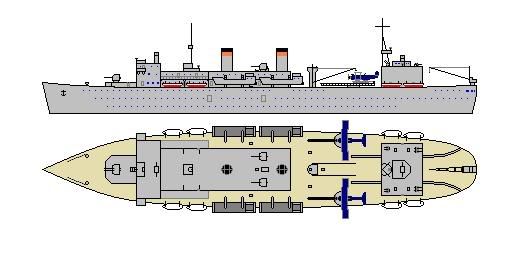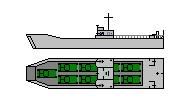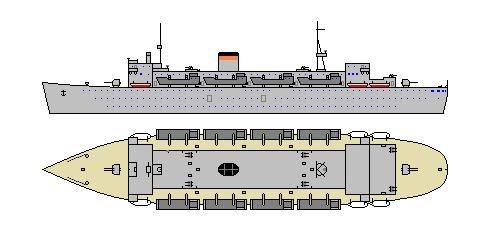[SIZE=3]Field Marshal Dhoni Class Landing Ship (Command)[/SIZE]

Experience in the Filipino revolution, the 1920 As Salif landing, and exercises along the way indicated that India could get by without specially built amphibious assault ships. This role would be taken up in wartime, if required, by refitting passenger lines in the Strategic Reserve.
However, command staff of the Marmorat Division found their improvised quarters aboard one of the passenger liners to be wholly inadequate for the job of actually planning and controlling their division's landing at Manipoc in January 1929. Among the criticisms:
-The command staff had no dedicated plotting and map rooms
-There was no dedicated space for other planning and administrative functions
-The staff had no direct access to aircraft for observation or photo-reconnaissance purposes
-Radio facilities onboard their liner were tied up with ship-to-ship functions.
-The overall layout of the ship was inefficient and hampered normal command staff operations.
In 1930, the passenger liner
Bengal Breeze, which had been used as the command ship, was requisitioned by the Bharatiya Nau Sena for conversion into a Landing Command Ship, with extensive consultation with the Marmorat divisional staff and officers from the Naval Infantry Command.
The aft superstructure has been gutted to provide facilities for two aircraft. Midships, balconies previously used by passengers for lounging about have been removed, and four 13 metre landing craft have been installed on heavy davits, for the transport of command staff between ship and shore.
Internally, passenger space has now been reconfigured. There is accomodation for the 725 men typically found in an infantry division's command battalion, and working space for them all, including a number of map/plotting and meeting rooms, plus a large auditorium for briefings. There are additional radio facilities, a lab for developing aerial photographs, and a small brig for detention of prisoners.
The ship is armed for self-defence, and remains unarmored. There is no intention that the ship will be used in shore-bombardment missions.
This is reckoned to be a 25% refit for the ship, which will be completed in mid-1931.
Field Marshal Dhoni, LSC-1, laid down 1922, converted 1930-31
Length, 129.0 m x Beam, 23.0 m x Depth, 4.9 m
8062 tonnes normal displacement (7160 tonnes standard)
Main battery: 4 x 10.5-cm
Secondary battery: 4 x 3.5-cm
AA battery: 8 x 1.5-cm
Weight of broadside: 67 kg
Miscellaneous Weight
1450 t: Accommodation for 725 men
100 t: Two catapults and four aircraft
1500 t: Working space
650 t: Extra boats, cranes, davits
Hull unarmored
Battery armor:
Main, 3.0 cm shields / secondary, 2.0 cm shields
AA, 2.0 cm shields
Maximum speed for 9995 shaft kw = 19.58 knots
Approximate cruising radius, 12000 nm / 12 knots
Typical complement: 425-553
Estimated cost, $3.530 million (£883,000)
Remarks:
Ship has slow, easy roll; a good, steady gun platform.
Excellent seaboat; comfortable and able to fight her guns
in the heaviest weather.
Magazines and engineering spaces are roomy, with superior
watertight subdivision.
Ship is roomy, with superior accommodation and working space.
Distribution of weights:
Percent
normal
displacement:
Armament ......................... 18 tonnes = 0 pct
Armor, total ..................... 11 tonnes = 0 pct
Armament 11 tonnes = 0 pct
Machinery ........................ 454 tonnes = 6 pct
Hull and fittings; equipment ..... 2803 tonnes = 35 pct
Fuel, ammunition, stores ......... 1075 tonnes = 13 pct
Miscellaneous weights ............ 3700 tonnes = 46 pct
-----
8062 tonnes = 100 pct
Estimated metacentric height, 1.2 m
Displacement summary:
Light ship: 6986 tonnes
Standard displacement: 7160 tonnes
Normal service: 8062 tonnes
Full load: 8751 tonnes
Loading submergence 2004 tonnes/metre
+++++++++++++++++++++++++
Estimated overall survivability and seakeeping ability:
Relative margin of stability: 1.10
Shellfire needed to sink: 7980 kg = 497.0 x 10.5-cm shells
(Approximates weight of penetrating
shell hits needed to sink ship,
not counting critical hits)
Torpedoes needed to sink: 2.7
(Approximates number of 'typical'
torpedo hits needed to sink ship)
Relative steadiness as gun platform, 80 percent
(50 percent is 'average')
Relative rocking effect from firing to beam, 0.02
Relative quality as a seaboat: 2.00
+++++++++++++++++++++++++
Hull form characteristics:
Block coefficient: 0.55
Sharpness coefficient: 0.42
Hull speed coefficient 'M' = 6.45
'Natural speed' for length = 20.6 knots
Power going to wave formation
at top speed: 47 percent
Estimated hull characteristics and strength:
Relative underwater volume absorbed by
magazines and engineering spaces: 71 percent
Relative accommodation and working space: 245 percent
Displacement factor: 169 percent
(Displacement relative to loading factors)
Relative cross-sectional hull strength: 0.90
(Structure weight per square
metre of hull surface: 426 kg)
Relative longitudinal hull strength: 2.85
(for 7.80 m average freeboard;
freeboard adjustment +3.38 m)
Relative composite hull strength: 1.01
+++++++++++++++++++++++++
[Machine-readable parameters: Spring Style v. 1.2.1]
423.12 x 75.44 x 16.07; 25.58 -- Dimensions
0.55 -- Block coefficient
1922 -- Year laid down
19.58 / 12000 / 12.00; Oil-fired turbine or equivalent -- Speed / radius / cruise
3700 tons -- Miscellaneous weights
++++++++++
4 x 4.13; 0 -- Main battery; turrets
Central positioning of guns
Gun-shields
:
4 x 1.38; 0 -- Secondary battery; turrets
Gun-shields
:
8 x 0.59 -- Tertiary (QF/AA) battery
Gun-shields
:
0 -- No fourth (light) battery
0 -- No torpedo armament
++++++++++
0.00 -- No belt armor
0.00 / 0.00 -- Deck / CT
1.18 / 0.79 / 0.79 / 0.00 -- Battery armor
(Note: For portability, values are stored in Anglo-American units)
+++++++++++++++++++++++++++++++++++++++++++++++++++++++



